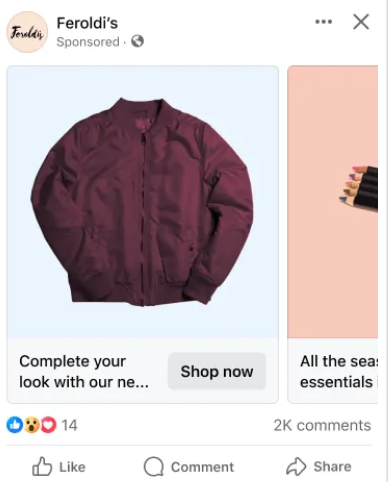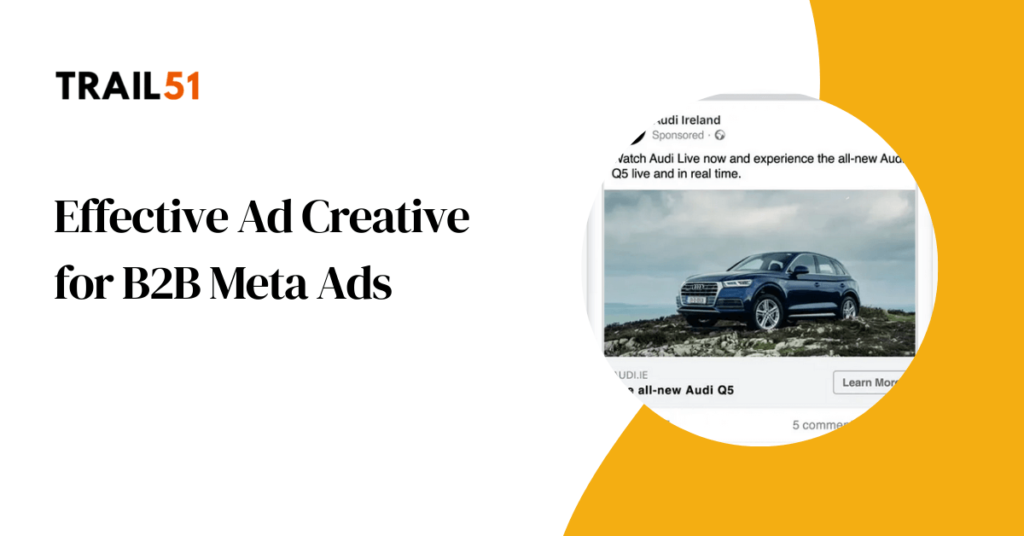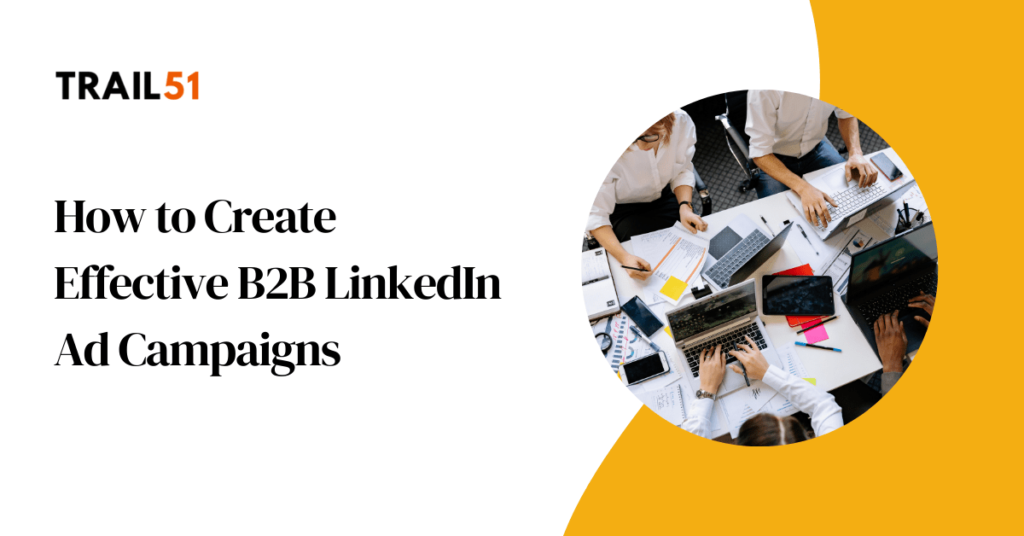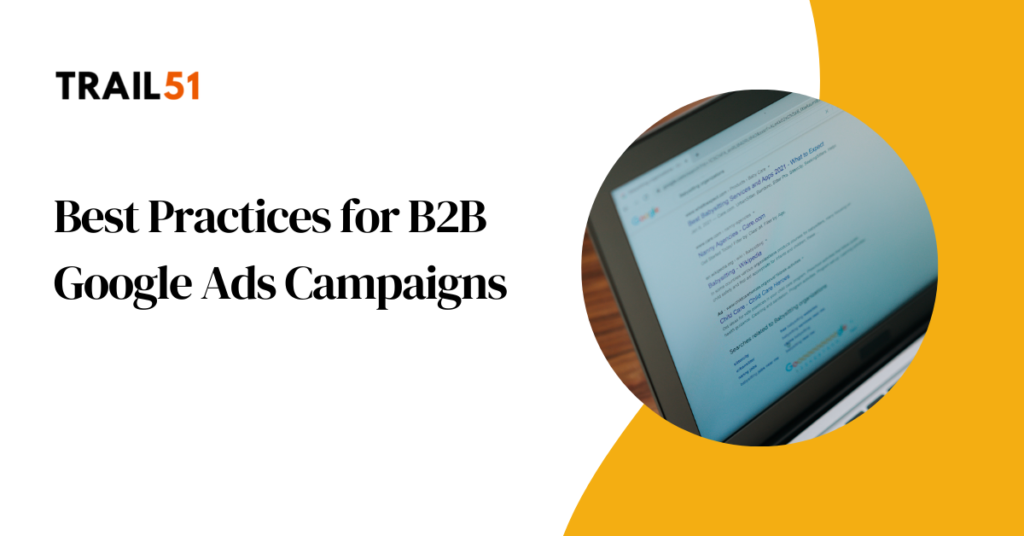Key takeways
- Target properly: Focus on job titles, industries, and company sizes with a bigger initial audience size
- Choose the right format: Image ads work for simple messages, videos tell stories, and carousel ads showcase multiple features
- Use eye-catching visuals: Pair with clear copy that addresses business pain points
- Test different versions: Use Meta’s tools to see which combinations perform best
- Retarget interested users: Connect with people who already know your brand
- Consider account-based marketing: Upload custom lists of high-value potential clients
- Align with sales stages: Create different ads for awareness, consideration, and decision phases
Understanding Your B2B Audience on Meta Platforms
Creating effective Meta ads for business customers starts with knowing exactly who you want to reach. Unlike ads for regular consumers, B2B ads need to speak to people making business decisions.
Meta platforms give you many ways to narrow down your audience. You can target people based on:
- Their job titles (like “Marketing Director” or “IT Manager”)
- The industries they work in (such as healthcare or finance)
- The size of their companies (small businesses versus large corporations)
- Professional interests and behaviors
When starting a new campaign, keep your audience fairly large—over 10,000 people is a good rule. This gives Meta’s system enough room to test and learn which specific people respond best to your ads.
Understanding the business problems your audience faces makes a huge difference. For example, IT managers might worry about security, while marketing directors might care more about showing results. Your ads should speak directly to these concerns.
The buying process for businesses is usually longer and involves more people than consumer purchases. Someone might see your ad, but they’ll need to convince others at their company before making a decision. This means your ads should provide clear value that the viewer can explain to others.
One helpful approach is to create different audience segments based on roles in the buying process:
| Role | What They Care About | Ad Focus |
| End User | Ease of use, features | How your product makes daily work better |
| Manager | Cost, efficiency, results | ROI and team benefits |
| Executive | Strategic value, big picture | How you solve business problems |
Remember that on Meta platforms, people aren’t necessarily in “work mode” when they see your ad. Your creative needs to grab attention quickly while still looking professional.
Testing is crucial with B2B audiences. Start with your best guess at targeting, then use Meta’s data to refine your approach. The platform will show you which specific segments respond best, helping you spend your budget more effectively over time.
Choosing the Right Ad Format for B2B Meta Campaigns
Picking the best format for your B2B Meta ads can make or break your campaign. Each format has strengths that work better for different goals.
Image Ads are the simplest format but don’t underestimate them. They load quickly and get straight to the point. For B2B marketing, clean, professional images work best—think of a person using your product or a simple graphic showing results. Image ads work well when:
- You need to create ads quickly
- Your message is straightforward
- You want to test multiple concepts without big production costs
Video Ads capture attention better than images and allow you to explain complex B2B products. The key is to grab interest in the first 3 seconds since many viewers will scroll past quickly. Short videos (15-30 seconds) typically perform best on Meta platforms. Consider using:
- Brief product demonstrations
- Customer testimonials
- Problem-solution scenarios relevant to business challenges
- Screen recordings of your software or platform in action
Carousel Ads let you show multiple images or videos that users can swipe through. This format is perfect for B2B because you can:
- Showcase different features of your product
- Walk through a step-by-step process
- Tell a more complete story about your service
- Display various case studies or results
Here’s a simple breakdown of when to use each format:
| Ad Format | Best For | Typical Length | Production Difficulty |
| Image | Quick campaigns, simple messages | One image | Low |
| Video | Explaining complex products, storytelling | 15-30 seconds | Medium-High |
| Carousel | Showing multiple features, sequential information | 3-5 cards | Medium |



The format should match your place in the buyer’s journey too. For example:
- Awareness stage: Use eye-catching image or video ads to introduce your solution
- Consideration stage: Try carousel ads showing different benefits or features
- Decision stage: Video testimonials or detailed image ads with specific offers
Don’t be afraid to mix formats within a campaign. Many successful B2B marketers test all three types to see what resonates with their specific audience.
Mobile optimization is crucial since most Meta users browse on phones. Make sure any text is readable on small screens and videos work well without sound (use captions!).
Testing different formats often reveals surprising results. A simple image might outperform an expensive video, or a carousel might drive more qualified leads than either. The only way to know for sure is to experiment with your specific B2B audience.
Creating Compelling Visuals and Copy That Convert
Creating B2B ads that actually work means getting both the pictures and words right. Unlike consumer ads that play with emotions, business ads need to be clear and useful while still catching attention.
For visuals, follow these principles:
- Use high-quality images that don’t look like stock photos
- Show your product being used in real business settings
- Include people when possible—faces grab attention
- Use charts or graphics that show clear results
- Keep designs clean with plenty of white space
- Use brand colors consistently for recognition
- Make sure anything important is visible on mobile screens
The biggest mistake in B2B visuals is being boring. Your ad competes with vacation photos and funny videos in the feed. It needs to stand out without looking unprofessional.
For the written part of your ad, focus on:
- Leading with the biggest benefit, not features
- Naming the specific problem you solve
- Using short sentences and simple words
- Including numbers and specific results when possible
- Adding social proof (“Used by 500+ marketing teams”)
- Creating a clear next step with your call-to-action
The structure of good B2B ad copy usually follows this pattern:
- Hook: Grab attention with a problem statement or surprising fact
- Value: Explain the main benefit clearly
- Proof: Show evidence it works (numbers, testimonials)
- Action: Tell people exactly what to do next
Here’s how this might look for different B2B products:
| Product Type | Hook Example | Value Example | Proof Example | CTA Example |
| HR Software | “Hiring taking too long?” | “Cut hiring time by 50%” | “Trusted by 300+ HR teams” | “Start free trial” |
| IT Security | “43% of businesses experienced a breach” | “Automatic threat detection” | “Prevents 99.7% of attacks” | “Get a security audit” |
| Marketing Tool | “Getting leads but not sales?” | “Convert 2x more prospects” | “See how Company X doubled conversions” | “Watch demo” |
Testing different combinations of visuals and copy is crucial. What works for one B2B audience might fail for another. Some businesses respond better to serious, data-driven ads while others prefer a more conversational approach.
When creating your ads, think about how they compare to B2B Google Ads you might be running. While the platforms differ, your core message should be consistent across channels.
Remember to keep your target company size in mind. Enterprise businesses often want to see stability and proven results, while smaller companies might care more about ease of use and quick implementation. Your visuals and copy should reflect these different priorities.
Advanced Targeting Strategies for B2B Meta Ads
B2B marketing on Meta platforms works best with precise targeting strategies. Simply showing ads to everyone wastes money and brings low-quality leads. These advanced approaches help you reach the right business decision-makers.
Account-Based Marketing (ABM) is perfect for B2B campaigns on Meta. This approach targets specific companies you’ve identified as ideal customers. Here’s how to implement it:
- Create a list of target companies (usually 50-200 businesses)
- Upload customer email lists to create a Custom Audience
- Layer job title targeting to reach decision-makers
- Create ads that speak to industry-specific problems
The key advantage is focus—you’re only paying to reach companies that match your ideal customer profile.
Lookalike Audiences help you find new prospects similar to your existing customers:
- Upload a list of your best current customers
- Meta finds common characteristics among them
- The platform then creates an audience of similar users
- You can adjust the similarity level (1-10%)
For B2B, smaller percentages (1-2%) usually work better because they’re more precise, even though they reach fewer people.
Job Title and Department Targeting lets you reach specific roles within companies:
- C-level executives (CEO, CFO, CTO)
- Department heads (Marketing Director, IT Manager)
- Specialists (Software Developer, Financial Analyst)
This works particularly well when paired with industry targeting. For example, targeting “Marketing Directors” in the “Healthcare” industry creates a highly relevant audience.
Behavior and Interest Targeting can supplement your approach:
- Target people who follow industry publications
- Reach users interested in competitor products
- Find people who engage with business content
While less precise than other methods, this can help expand your reach when needed.
Combining Targeting Methods often yields the best results. Consider this layered approach:
- Start with industry and company size filters
- Add relevant job titles
- Include interest targeting related to your solution
- Exclude current customers (unless running retention campaigns)
When comparing these approaches to B2B LinkedIn Ads, Meta typically offers lower costs but requires more targeting work to find professionals. LinkedIn’s targeting is more precise for B2B but usually comes with higher costs per click.
The best practice is to create multiple ad sets with different targeting strategies, then allocate more budget to those that perform best. Start broader than you might think, then narrow based on results.
Remember that privacy changes have limited some targeting options. Focus on building first-party data (like email lists) that you can leverage for Custom and Lookalike audiences, as these remain highly effective despite platform changes.
Optimizing B2B Ad Performance
Getting B2B ads right rarely happens on the first try. Success comes from careful testing and improvement over time. Meta provides powerful tools that help you optimize your business ads.
Dynamic Creative Optimization (DCO) lets you test multiple elements at once:
- Upload various headlines (5-10 options)
- Add different images or videos (2-5 versions)
- Include several primary text variations
- Test different CTAs
The system mixes these elements to find winning combinations. For B2B, this helps discover which specific benefits or features resonate most with decision-makers. It saves time and removes guesswork.
A/B testing requires a structured approach:
- Test only one element at a time (image, headline, etc.)
- Run tests for at least 3-5 days to gather enough data
- Aim for statistical significance before making decisions
- Keep good records of what worked and what didn’t
Common B2B elements worth testing include:
| Element | Test Ideas |
| Value proposition | ROI focus vs. time-saving focus |
| Imagery | People using product vs. data visualization |
| Call-to-action | “Get demo” vs. “Download guide” |
| Ad format | Single image vs. carousel format |
Budget optimization becomes easier with Meta’s campaign budget optimization (CBO) feature. This automatically distributes your budget to the best-performing ad sets. For B2B advertisers with multiple audience segments, this ensures money goes where it works best.
The key metrics to track for B2B ads differ from consumer campaigns:
- Click-through rate (CTR): Shows if your ad captures attention
- Conversion rate: Measures how many clicks become leads
- Cost per lead (CPL): Tells you what you’re paying for each prospect
- Lead quality score: Track how many leads become actual sales
- Return on ad spend (ROAS): The ultimate measure of campaign success
Create a simple tracking dashboard with these metrics for each campaign. Review weekly to spot trends and opportunities for improvement.
Performance marketing services for B2B should take a longer view than consumer campaigns. The sales cycle is typically longer, so immediate conversions may be lower while still delivering good ROI over time.
Setting up proper conversion tracking is crucial. Install the Meta pixel on your website and configure it to track meaningful business actions like:
- Form submissions
- Resource downloads
- Demo requests
- Free trial signups
Landing page optimization is just as important as the ad itself. Make sure your landing pages match the promise of your ad and load quickly on mobile devices. A great ad followed by a poor landing experience wastes your budget.
Retargeting Techniques for the B2B Sales Cycle
Retargeting changes everything for B2B advertising on Meta platforms. Instead of cold outreach to new prospects, you’re reconnecting with people who already showed interest. This dramatically improves conversion rates and lowers costs.
The B2B buying journey is rarely quick. Decision-makers might research solutions for weeks or months before taking action. Retargeting keeps your brand visible during this extended process.
Website visitor retargeting forms the foundation of most B2B retargeting strategies:
- Install the Meta pixel across your website
- Create custom audiences based on specific page visits
- Segment visitors by the content they viewed
- Develop ads that build on their demonstrated interests
For example, someone who viewed your pricing page gets different ads than someone who only read a blog post. The first user might see case studies, while the second receives a guide offering more basic information.
Sequential storytelling takes retargeting further by showing a planned series of ads:
- First ad: Introduces a business problem and your solution
- Second ad: Shows how your product works
- Third ad: Presents case studies and results
- Final ad: Offers a demo or consultation
This approach mimics the natural decision-making process in businesses. Each ad builds on previous knowledge rather than repeating the same message.
Engagement retargeting reaches people who interacted with your previous ads or content:
- Watched your video (create audiences at different watch durations)
- Engaged with your page posts
- Clicked on previous ads but didn’t convert
- Interacted with your Lead Forms
These audiences typically show higher intent than website visitors alone.
Duration settings matter significantly in B2B retargeting. While consumer products might use 7-30 day windows, B2B campaigns often benefit from longer retargeting periods:
| Audience Type | Suggested Duration | Reasoning |
| Basic website visitors | 30-60 days | Keeps brand awareness during research phase |
| High-intent pages (pricing, demo) | 60-90 days | Captures prospects in active buying mode |
| Form abandoners | 14-30 days | Recaptures lost opportunities quickly |
| Past customers | 180+ days | Enables cross-selling or upgrades |
Frequency capping prevents ad fatigue. Set limits so prospects see your ads regularly but not excessively. For most B2B Meta ads, 2-3 impressions per week strikes the right balance between staying visible and avoiding annoyance.
Creating special content offers for retargeting audiences often increases conversion rates. Someone who already visited your site might respond to a detailed case study, ROI calculator, or industry report—assets that wouldn’t work as well for cold audiences.
Finally, don’t forget to exclude converters from your retargeting campaigns. Once someone becomes a lead or customer, they should move to different nurturing campaigns rather than continuing to see lead generation ads.
Aligning Ads with the B2B Sales Funnel
B2B purchases involve multiple decision stages. Your Meta ads should match where potential customers are in their buying journey. This alignment improves results because you’re showing the right content at the right time.
The B2B sales funnel typically has three main stages:
1. Awareness Stage (Top of Funnel) At this point, businesses recognize they have a problem but may not know about solutions. Your ads should:
- Educate about the problem
- Introduce your company as a potential solution
- Offer valuable content without asking for much in return
Effective ad content for this stage includes:
- Industry reports and trend analysis
- Educational blog posts
- Short explainer videos
- Quick tips and statistics
The call-to-action should be low-commitment, like “Learn More” or “Download Free Guide.” The goal is to start the relationship, not push for an immediate purchase.
2. Consideration Stage (Middle of Funnel) Now businesses are actively comparing solutions. Your ads should:
- Demonstrate your unique advantages
- Provide evidence that your solution works
- Address common concerns or objections
Content that works well here includes:
- Case studies from similar companies
- Product comparison guides
- Webinar invitations
- Feature demos and walkthroughs
CTAs become slightly stronger, such as “Watch Demo” or “Join Webinar.” You’re asking for more time commitment as interest increases.
3. Decision Stage (Bottom of Funnel) Prospects are ready to make a choice. Your ads should:
- Provide the final push toward conversion
- Offer direct contact with sales or easy ways to start
- Remove any remaining friction or doubts
Effective content includes:
- Free trials or assessments
- Consultation offers
- ROI calculators
- Customer testimonial videos
CTAs become direct: “Start Free Trial,” “Get Quote,” or “Book Consultation.”
This table shows how ad elements change across the funnel:
| Funnel Stage | Ad Objective | Content Type | Best Ad Format | CTA Example |
| Awareness | Brand awareness, Reach | Educational content | Video, Image | “Download Guide” |
| Consideration | Traffic, Engagement | Case studies, Webinars | Carousel, Video | “Watch Demo” |
| Decision | Lead generation, Conversion | Trials, Consultations | Image, Lead Form | “Book Call” |
Many B2B Google Ads focus on capturing bottom-funnel searches, but Meta excels at reaching people earlier in their journey. This complementary approach builds a stronger overall funnel.
When building your funnel-aligned campaigns, create audience segments that match each stage:
- Awareness: Broader targeting based on job titles and industries
- Consideration: Website visitors, content downloaders, video viewers
- Decision: High-intent page visitors, previous lead form starters
Track how prospects move through these stages. If you see good engagement at the top but few conversions at the bottom, you may need to improve your middle-funnel content or offers.
Remember that B2B sales cycles can last months. Budget for consistent presence across all funnel stages rather than expecting immediate results from decision-stage ads alone.
Successful B2B Meta Ad Examples and Case Studies
Learning from successful B2B ads can spark ideas for your own campaigns. Let’s examine what works for different companies and why their approaches get results.
Mailchimp’s Feature-Focused Approach Mailchimp uses bright, simple visuals combined with direct messaging about specific features. Their ads work because they:
- Use distinctive brand colors that stand out in the feed
- Focus on one feature per ad rather than overwhelming viewers
- Speak directly to small business pain points
- Include clear before/after scenarios
One successful campaign highlighted their new AI content tools with the simple headline: “Write marketing emails in seconds, not hours.” The ad used a split-screen showing a frustrated person typing versus someone smiling with Mailchimp’s solution. This clear contrast connected with busy small business owners.
Shopify’s Aspirational B2B Advertising Shopify’s B2B ads succeed by showing the growth potential for businesses:
- Feature real customer stories with specific results
- Use authentic imagery rather than stock photos
- Include actual revenue numbers when possible
- Show the platform being used in various industries
Their carousel ads often showcase different business types succeeding with their platform. Each card tells a mini-story about a different entrepreneur, helping various B2B audiences see themselves using the product.
HubSpot’s Educational Approach HubSpot excels with content-driven ads that:
- Offer valuable resources without aggressive selling
- Establish thought leadership in marketing and sales
- Use data visualizations that stop scrolling
- Create natural progression toward their products
Their “Marketing Statistics Report” campaign generated thousands of leads by offering genuinely useful industry data. The ads featured eye-catching charts with surprising statistics, making marketers want to download the full report.
Slack’s Problem-Solution Framework Slack’s successful ads typically:
- Name a specific communication problem
- Show how their platform solves it
- Use simple animations to demonstrate features
- Highlight integration with other business tools
One particularly effective campaign targeted teams transitioning to remote work. The ads showed the chaos of scattered communications, then demonstrated how Slack creates organization. This timely, problem-focused approach generated strong results.
Adobe’s Cross-Channel Strategy Adobe effectively coordinates B2B LinkedIn Ads with Meta campaigns by:
- Using consistent messaging across platforms
- Tailoring creative elements to each platform’s strengths
- Retargeting LinkedIn engagers on Meta platforms
- Creating platform-specific landing pages
Their “Creative Cloud for Teams” campaign maintained core messaging about collaboration while adjusting visuals and tone for each platform. On LinkedIn, they used more formal case studies, while on Meta, they showed more dynamic, attention-grabbing visuals of the product in action.
The key takeaways from these successful examples include:
- Focus on specific problems and solutions rather than generic statements
- Use authentic imagery showing your product in real settings
- Test multiple formats to find what works for your specific audience
- Create ad sequences that guide prospects through the funnel
- Maintain consistent branding while adapting to each platform
When analyzing your own campaigns, look beyond surface metrics. The most impressive-looking ad isn’t always the best performer. Regular testing and optimization based on actual results will outperform even the most creative guesswork.
Frequently Asked Questions
Yes, Meta ads can be very effective for B2B marketing when properly targeted. While LinkedIn is often considered the primary B2B platform, Meta offers larger scale, better targeting tools, and typically lower costs per lead. Many B2B companies see strong results, particularly for awareness and consideration stage marketing.
For effective testing, start with at least $1,000-2,000 per month. This allows you to test different audiences and creative approaches. Once you find working combinations, successful B2B campaigns often spend $5,000-20,000 monthly depending on company size and goals. Start small, measure results, then scale what works.
There’s no single “best” format for all B2B companies. Image ads often work well for simple messages and quick testing. Video ads typically generate higher engagement and work well for explaining complex products. Carousel ads excel at showcasing multiple features or benefits. Test all three to see what works for your specific business.
Focus on these proven tactics: create audience segments based on specific industries or roles, use retargeting for website visitors, craft clear benefit-focused headlines, ensure landing pages match ad promises, test different offers (guides vs. demos), and implement lead form optimization. Regular testing and refinement are key.
Track beyond initial conversions since B2B sales cycles are typically longer. Set up proper attribution by connecting your CRM to your Meta ads account. Track metrics throughout the funnel: ad engagement, landing page conversion, lead quality, sales qualified leads (SQLs), and closed deals. Calculate customer acquisition cost compared to customer lifetime value for true ROI.
Refresh creative elements every 2-4 weeks to prevent ad fatigue. Major message changes should align with campaign objectives and market conditions. Test new variations regularly while maintaining your best performers. B2B audiences typically respond to substantive information updates rather than merely changing colors or layouts.



